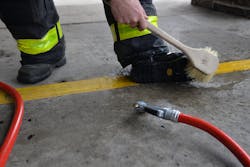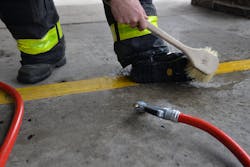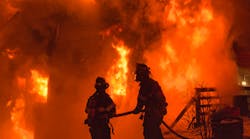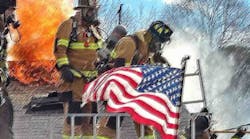There has been a great deal of emphasis on reducing occupational exposure to fireground contamination. Firefighters are at an increased risk for cancer and other diseases that scientific research has linked to firefighting. The reality is that firefighting is a dirty job, and we will never eliminate all of the hazards we face. We can, however, minimize and manage these hazards. Individuals must make their own commitment to their health and well-being. Collectively, we must apply the same smart, aggressive approach that we already use with firefighting and extend that mindset to reduce our risk.
15 Tips to Minimize Risk
-
Always use your SCBA, including when operating at car fires, dumpster fires and during overhaul. The SCBA provides the best respiratory protection from inhalation hazards
-
Take a shower and change into clean station wear as soon as possible after returning from a fire. This should be done prior to cleaning tools. The concept is to “place the firefighter back in service first” to minimize time spent exposed to harmful contaminants.
-
Wash off bunker boots after a working fire. Boots contribute significantly to cross-contamination.
-
Keep hard surfaces inside the crew cab of the apparatus clean. Contaminants are known to settle on these areas, contributing to cross-contamination.
-
Thoroughly wash your hands after every response, as well as before and after using the bathroom. This will minimize cross-contamination to highly absorptive areas of the body.
-
Remove PPE—such as hoods and gloves—in a manner that minimizes cross-contamination. Think of contaminated firefighting gloves as you would blood-soaked medical gloves.
-
Don’t overlook your helmet. Wash the inside liner of your helmet with soap and water.
-
Use gear bags when transporting PPE to minimize cross-contamination. Do not store bunker gear in your car or home.
-
Wash your dirty gear. Dirty gear demonstrates that you are naïve to the risks posed by fireground contaminants.
-
Don’t use a contaminated hood or leave one around your neck following a fire. This greatly increases exposure around the neck, one of the most absorptive areas of the body.
-
Practice healthy lifestyle choices. Exercise regularly; limit or avoid alcohol, tobacco products and red meat intake; and always use sunscreen.
-
Ensure diesel exhaust capture systems are working properly and used. Diesel is a known carcinogen.
-
Perform on-scene decontamination of contaminated gear and equipment following a working fire to remove soot, which is composed of harmful compounds that can cause cancer and other illnesses.
-
Shower prior to leaving the firehouse after your tour ends, regardless of the amount of firefighting activity during the tour. This minimizes the risk of cross-contamination.
-
Maintain and strictly enforce “no bunker gear zones” in all living areas of the firehouse.

Frank Leeb
Frank Leeb is the managing director of the First Responder Center for Excellence. He previously served as a deputy assistant chief in FDNY, retiring in June 2024 after more than 31 years. During his tenure with FDNY, Leeb held several senior staff positions, including chief of the fire academy, chief of training and chief of safety. He also has been a member of the East Farmingdale, NY, Volunteer Fire Department since 1983. Leeb holds a bachelor's degree in fire service administration from SUNY Empire State and a master’s degree in security studies from the Naval Postgraduate School, Center for Homeland Defense and Security. He served as an advisory panel member for UL's Fire Safety Research Institute's "Study of Coordinated Fire Attack Utilizing Acquired Structures" and was the keynote speaker for Firehouse Expo in 2022 and FireFusion 2024. Leeb is the author of "Cornerstones of Leadership: On and Off the Fireground." He was a presenter at the 2022 and 2023 U.S. Fire Administrator Summit on Fire Prevention and Control. Leeb can be contacted at [email protected].










